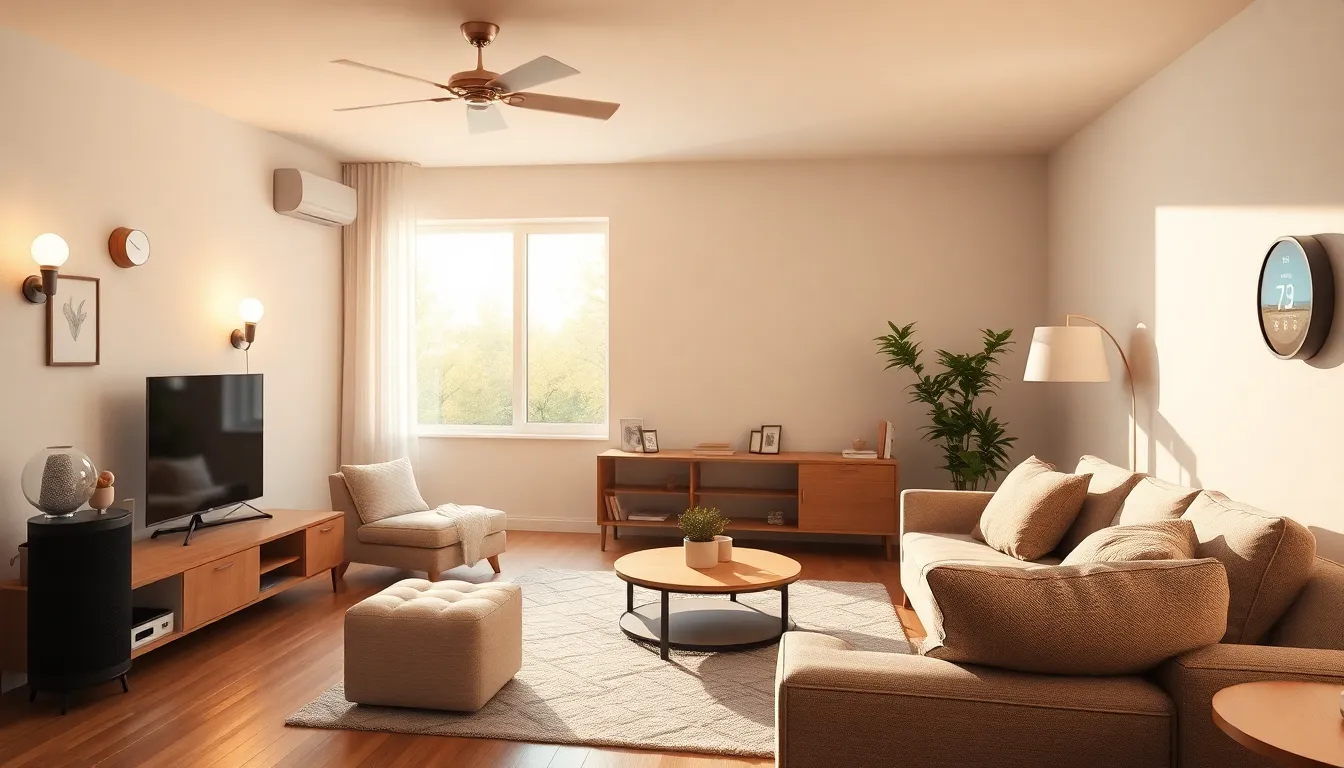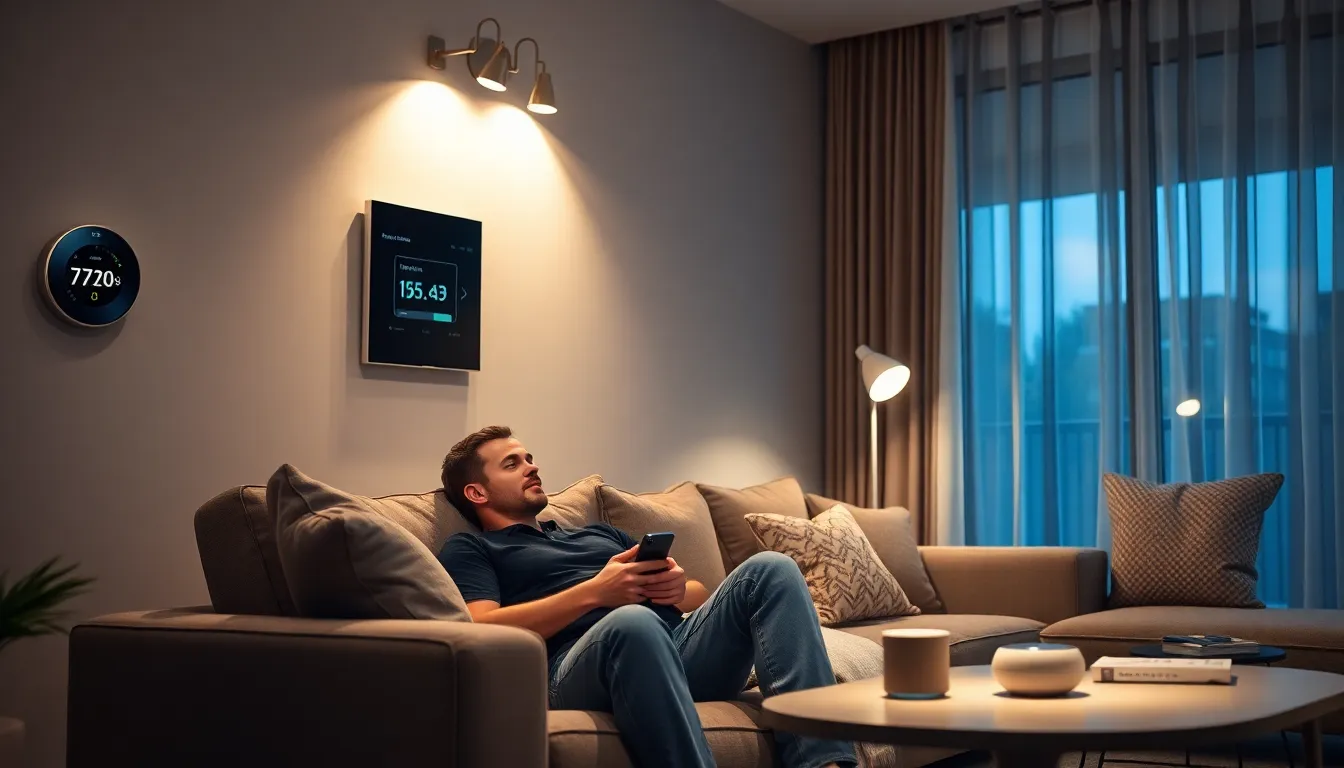Smart home technology is revolutionizing the way people interact with their living spaces. It seamlessly integrates devices and systems to enhance convenience, security, and energy efficiency. From smart thermostats that learn individual preferences to voice-activated assistants that control everything with a simple command, these innovations are transforming homes into intelligent environments.
As homeowners embrace this technology, they discover the benefits of automation and remote access. Imagine adjusting your lights or locking your doors from anywhere in the world. With the rise of the Internet of Things (IoT), smart home devices communicate effortlessly, creating a network that simplifies daily tasks and enhances overall quality of life. This article explores the latest trends, benefits, and challenges of smart home technology, offering insights into how it can elevate everyday living.
Table of Contents
ToggleOverview Of Smart Home Technology
Smart home technology encompasses devices connected through the Internet of Things (IoT) that automate tasks, enhance security, and improve energy efficiency. This integration allows users to control appliances, lighting, heating, and more from smartphones or voice-activated assistants. Key components include:
- Smart Thermostats: These devices learn user behavior and optimize heating and cooling for energy savings, often reducing utility bills by 10–15%.
- Smart Lighting: Adjusts brightness and color based on user preferences or schedules, leading to energy savings and increased convenience.
- Smart Security Systems: Incorporate surveillance cameras, motion detectors, and doorbell cameras, providing real-time alerts and remote monitoring capabilities.
- Smart Appliances: Devices like refrigerators and ovens can be managed remotely, allowing for efficient meal preparation and inventory tracking.
- Voice Assistants: Devices such as Amazon Alexa or Google Assistant facilitate hands-free control of smart home systems.
Smart home technology promotes a connected living experience, streamlining daily routines while enhancing safety and comfort. As adoption rates increase, homeowners benefit from innovative solutions that cater to diverse needs and lifestyles.
Benefits Of Smart Home Technology

Smart home technology provides numerous advantages that significantly enhance the living experience. These benefits include increased convenience, security, and energy efficiency, making homes smarter and lives easier.
Enhanced Convenience
Enhanced convenience defines smart home technology’s impact on daily living. Homeowners use smart devices for remote control of appliances, lighting, and climate settings from smartphones or voice commands. Smart assistants simplify tasks like setting reminders and managing schedules. Automation enables routines, such as lights turning on at sunset or thermostats adjusting based on occupancy. These features eliminate the need for manual adjustments, saving time and effort.
Improved Security
Improved security illustrates another critical advantage of smart home technology. Smart security systems integrate cameras, sensors, and alarms to provide real-time monitoring. Homeowners receive alerts on suspicious activity via smartphones, offering immediate insights into their properties. Features like smart locks allow for remote locking or unlocking, ensuring entry only for authorized individuals. Additionally, integration with surveillance systems strengthens property protection, offering peace of mind for homeowners.
Popular Smart Home Devices
Smart home devices enhance everyday living, providing convenience, efficiency, and security. Here’s a closer look at some of the most popular options.
Smart Speakers
Smart speakers serve as multifunctional hubs, enabling voice control over various devices. With built-in virtual assistants like Amazon Alexa, Google Assistant, or Apple Siri, users can access music, news, or weather updates effortlessly. Smart speakers often connect with other smart devices, allowing users to streamline routines by controlling lights, thermostats, or security systems through voice commands.
Smart Thermostats
Smart thermostats optimize energy consumption while ensuring comfort. These devices learn user behavior and adjust heating and cooling automatically, resulting in energy savings of up to 10-15% on utility bills, according to the U.S. Department of Energy. Features may include remote access through mobile apps, geofencing capabilities that adjust settings based on user location, and integration with other smart devices. Popular models include the Nest Learning Thermostat and Ecobee SmartThermostat.
Smart Security Cameras
Smart security cameras enhance home security with real-time monitoring and alerts. Equipped with motion detection and night vision, these cameras provide comprehensive surveillance, alerting homeowners to any unusual activity. Users can view live feeds and recorded footage through dedicated mobile apps. Integration with smart doorbells and security systems adds layers of protection. Brands like Ring and Arlo offer advanced features, including two-way audio and cloud storage options.
Challenges And Considerations
Smart home technology presents several challenges that homeowners must consider to maximize their benefits and mitigate potential risks.
Privacy Concerns
Privacy concerns rank high among smart home technology challenges. Smart devices often collect personal data, including usage patterns and preferences. Unauthorized access or data breaches can expose sensitive information. Users must implement strong security measures, such as robust passwords and two-factor authentication. Regularly reviewing privacy settings and being aware of data sharing policies from device manufacturers further protects personal information.
Compatibility Issues
Compatibility issues frequently arise with smart home devices. Many manufacturers develop proprietary systems, complicating integration with existing devices. Homeowners may face difficulties when trying to connect a new gadget to an established ecosystem, leading to frustration and reduced functionality. Researching compatibility before purchasing devices ensures seamless integration within the smart home network. Selecting products that adhere to universal standards, such as Zigbee or Z-Wave, enhances compatibility and simplifies the setup process.
Future Trends In Smart Home Technology
Future trends in smart home technology focus on enhanced integration, improved usability, and advanced automation. Notable developments include:
- AI and Machine Learning
AI and machine learning algorithms offer personalized experiences. Devices learn user habits, adapt settings, and optimize energy use over time.
- Voice Control Advancements
Voice control continues to progress. Natural language processing enables more complex commands, allowing for seamless interactions with smart home devices.
- Interoperability Standards
Interoperability standards like Matter gain traction. These standards create compatibility across diverse smart home devices, simplifying user experience.
- Energy Management Technologies
Energy management technologies promote sustainability. Smart grids and energy-efficient appliances work together, allowing homeowners to optimize energy consumption and reduce costs.
- Enhanced Security Features
Enhanced security features, including advanced facial recognition and biometric access, improve home safety. Users benefit from real-time alerts and smart video doorbells that identify visitors.
- Health and Wellness Integration
Health and wellness integration becomes more prevalent. Smart health monitors and air quality sensors help homeowners maintain a healthy living environment.
- Augmented Reality Interfaces
Augmented reality interfaces provide intuitive control options. Homeowners visualize smart home settings and interact with devices through overlays on their mobile devices.
- Robotics in Home Automation
Robotics enhances home automation, with robotic vacuums and lawn mowers becoming commonplace. These devices automate routine chores, saving time and effort.
These trends indicate a future where smart home technology becomes more user-friendly, secure, and efficient, transforming living spaces into fully connected ecosystems.
Smart home technology is revolutionizing modern living by enhancing convenience security and energy efficiency. As homeowners embrace these innovations they gain unprecedented control over their environments. The integration of devices not only simplifies daily tasks but also creates a more connected and efficient lifestyle.
Looking ahead the future of smart homes promises even greater advancements with AI-driven automation and improved interoperability. These developments will further elevate the user experience making smart homes more intuitive and secure. As technology continues to evolve homeowners can expect their living spaces to transform into seamless ecosystems that cater to their every need.




